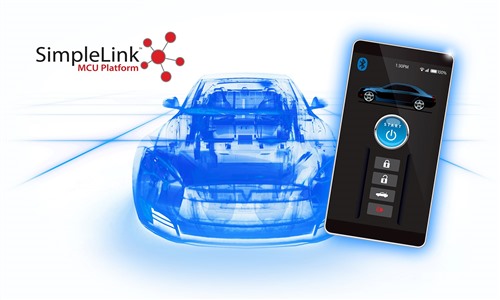SSZT940 october 2017 CC2640R2F , CC2640R2F-Q1 , CC2642R-Q1

It’s 7 a.m. on a Monday morning. You’re walking toward your car with coffee and lunch in one hand while on a phone call with the other hand. Now, where are those keys, and how are you going to reach them with your hands full? No worries! Your smartphone’s got you covered.
Your phone connects to your vehicle using Bluetooth low energy technology. As you approach, the vehicle immediately knows your location – how close and what direction you are coming from. When you get closer, the exterior lights turn on, your phone authenticates your identity and your car door automatically unlocks. Simply get in, start your car and go. Your phone is now your key fob!
This is not the future; in fact, it is quickly becoming a reality. Car manufacturers all over the world are enabling smartphones as a key to make our lives more convenient, since we’ll have one less thing to find in the morning. Bluetooth low energy is a low-power 2.4GHz wireless technology that is the foundation of connecting smartphones for car access. And once connected, the possibilities are endless.
The automotive-qualified SimpleLink™ Bluetooth low energy CC2642R-Q1 wireless microcontroller (MCU) is Automotive Electronics Council (AEC)-Q100 compliant and targets Bluetooth 4.2 and Bluetooth 5 automotive applications. Bluetooth 5 enables four times the range over a Bluetooth 4.2 solution and now makes it possible to start your car from the kitchen, your bedroom or your driveway. A long range also means more robust connections in the harsh automotive environment.
In addition to car access applications, which mainly reside in the gateway or body control module, other applications are using Bluetooth low energy inside the vehicle. Telematics modules are using Bluetooth low energy to enable smartphone connectivity for car sharing. If you are on vacation and want to let a friend borrow your car, it’s just a matter of transferring the virtual key to them. And while a smartphone may be the main device for car access in the future, you would still need a key fob as backup. Passive entry passive start (PEPS) and remote keyless entry (RKE) fobs can use the same Bluetooth low energy ecosystem connecting a smartphone to a vehicle.
In all of these applications, the CC2640R2F-Q1 wireless MCU provides an AEC-Q100 grade 2 temperature-rated solution in a wettable flanks package. Additionally, excellent receiver sensitivity and programmable output power provides industry leading RF performance that is required for the demanding automotive RF environment. Make mornings easier by empowering your automotive systems to be more automatic with TI’s Bluetooth low energy solutions.
Additional Resources
- Glean some helpful hints for designing a Bluetooth low energy solution in the application report, “Design Considerations for High Temperature Applications Using the CC2640R2F-Q1 AES Q100 Qualified Bluetooth Low Energy Wireless MCU.”
- Read the white paper, “Bluetooth low energy and the automotive transformation,” which explores this technology and its use cases inside vehicles.
- Learn more about the CC2640R2F-Q1 wireless MCU’s long-range capabilities in this TI training video, “Long Range with CC2640R2F.”
- Learn more about TI’s automotive solutions: www.ti.com/Automotive.